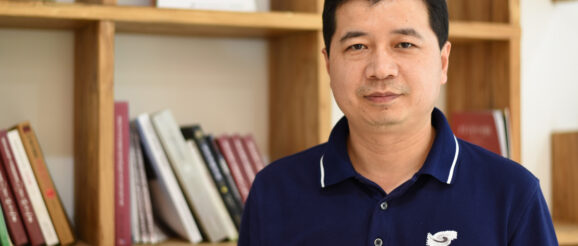Using particle physics to foster medical innovation – Physics World

What are your main areas of research at the Institute of High Energy Physics (IHEP), Chinese Academy of Sciences?
My interest focuses on radiation imaging and its applications in medical physics and industry. This includes the design of X-ray and gamma-ray detectors, imaging algorithms as well as systems development.
How did you get into medical imaging?
For my PhD, I worked on IHEP’s Beijing Electron Positron Collider, which gave me experience in radiation measurements of positron annihilation. When I graduated in 2006, I began research on radiation-imaging technologies such as positron emission tomography (PET), single-photon emission computed tomography (SPECT) and computerized tomography (CT). Since 2008 research into radiation-imaging technology that has been carried out at IHEP’s division of nuclear technology and applications has achieved a number of breakthroughs in PET and SPECT detector development. Such work has especially benefited from the development of electronics and detection technology during the construction of big-science facilities at IHEP.
Do you have an example?
With the rapid development of the Chinese medical-imaging market, our team has co-operated with companies to develop devices such as a dedicated breast-PET (PEMi) scanners. We have now completed more than 500 clinical test runs and in 2015 received certification from the China Food and Drug Administration. Now it is being used for early breast cancer diagnosis in clinical settings – an important addition to improving breast cancer survival rates.
How important is technology transfer at IHEP?
It is very important. In IHEP’s strategic outlook, technology transfer is as critical as the construction of big-science facilities and basic scientific research. Most research centres in IHEP have been involved in technology transfer to some degree, with IHEP also setting up a dedicated technology-transfer office and a spin-out company.
Each of IHEP’s big-science facilities has led to the development of multiple disciplines and technologies.
What are some of the technologies that IHEP has spun out of its research?
The main technologies that have been successfully transferred are accelerator and medical-imaging technologies, such as the PEMi scanner. As IHEP makes large accelerators and their core components, we have also developed high-power electronic irradiation accelerators that are being used for the sterilization of food and medical equipment. These accelerators have already been installed in Yantai, Wuhan, Tianjin and other regions around China.
Many of the technologies at IHEP seem suited for medical applications. Why is this?
The dominant technologies of IHEP are accelerator, nuclear detection and nuclear electronics technologies, which are exactly the type of technologies that are needed in nuclear medicine, radiotherapy and medical diagnosis. National funding projects give support for these areas of medical physics and there are many companies in this area that we collaborate with.
What kind of innovations do you see in the future?
Given advanced detector and electronics technology, we see developments such as high resolution – i.e. less than 100 picoseconds – time-of-flight PET technology that can increase the resolution of images and reduce the radiation dose to patients. Another aspect in medical applications is “static spectral” CT scanners, which will also allow for high-resolution imaging. In addition, the integration of diagnosis and treatment, especially in precision-particle therapy is another development I see in the future.
Do you collaborate on technology transfer with other countries?
Not yet, but international cooperation is an aspect that we are interested to grow.
With China designing a 100 km collider, do you envisage a similar emphasis on technology transfer when planning that project?
Each of IHEP’s big-science facilities has led to the development of multiple disciplines and technologies. Pixel-detector technology, for example, is involved in almost every scientific project, so we will accumulate more technical knowledge in this field as we advance. Combining the emphasis on detector development with medical-imaging equipment, we plan to focus on pixel-type semiconductor-detector technology by developing an advanced sensing chip and utilizing it in the next generation of CT and SPECT scanners.
Has COVID-19 affected your research?
COVID-19 has not really had any effect on our lab and we have continued to carry on with our research during the pandemic.
The post Using particle physics to foster medical innovation appeared first on Physics World.
